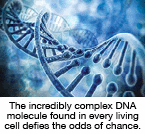Return to July/August 2015 articles.


For … those things of God which the eye is unable to see ever since the world was made have been clearly perceptible and understandable through the things he has made, even his everlasting power and divine character so that men have no excuse. (Romans 1:20, The Word: The Bible from 26 Translations)
Throughout the entire Bible, God has encouraged us to study the creation and learn from it. The writers of Psalms overflowed with repeated admonitions on all kinds of subjects. Psalm 19:1 encourages us to look into space and at the world around us. Psalm 139:14 tells us to look at our bodies and marvel at their design. Proverbs 6:6 urges us to look at the ant as an example of God's design of living things. Proverbs 8 enlists “wisdom” to urge us to look at the logistics of creation — in some cases seemingly bringing out concepts of quantum mechanics, and the role of wisdom in all aspects of the creation. In Matthew 6:26 – 33 Jesus refers his listeners to the beauty of the world around them in flowers and the provision of God to birds.
In the twenty-first century, we have so much evidence of God's planning and design in the world around us that the words of the Bible writers ring truer than ever. We can look deeper into space and gather light from the very beginning of the creation. We can smash atoms to bits and by looking at the bits know how the atom was designed. We can look at the very building blocks of life and see many things that tell us about forces and techniques that allow life to exist and to survive in a world that is hostile to the fragile elements that comprise life.
INTUITIVE DESIGN
 The simplest and easiest way to see the evidence of God's design is just to look at what we observe and ask how it is possible for such a thing to come into existence? In this journal we have had a column that we call “Dandy Designs” which shows this type of evidence. That column has been in every issue since 1972 with two examples in each issue. That means we have described more than 1,000 examples of things to look at and think about that have taken mankind centuries to understand. Thus, they obviously required planning, wisdom, and design to come into existence. The question is whether such evidence demands that God did each of these things or whether there are natural processes that culminate in what we observe. Naturalism is the faith offered by skeptics as an alternative to believing that God did all of these things.
The simplest and easiest way to see the evidence of God's design is just to look at what we observe and ask how it is possible for such a thing to come into existence? In this journal we have had a column that we call “Dandy Designs” which shows this type of evidence. That column has been in every issue since 1972 with two examples in each issue. That means we have described more than 1,000 examples of things to look at and think about that have taken mankind centuries to understand. Thus, they obviously required planning, wisdom, and design to come into existence. The question is whether such evidence demands that God did each of these things or whether there are natural processes that culminate in what we observe. Naturalism is the faith offered by skeptics as an alternative to believing that God did all of these things.
Two things need to be pointed out about naturalism. The first is that natural explanations for what appear to be designed and planned properties of organisms are not just blind statements of faith. Using principles of Darwinian evolutionary change, a reasonable scenario can be developed in many cases for whatever it is we observe. Migrations, for example, can be explained by the simple and obvious point that animals that migrate out of a lethal environment will survive and animals that do not migrate will not. The second point is that being able to propose a possible scenario for how something came about does not mean that the proposed scenario actually happened that way. Atheists tend to present the notion that if they can build any kind of model that might explain something observable in nature, that the model is a proven fact. In many cases, the model has so many statements of possible events that it requires massive faith to accept them all. In one of my biology books explaining hibernation the word “if” was in the explanation 32 times.
Intuitive design is a valid argument for the existence of God for two primary reasons. The first is that the number of examples is so massive, and the number of conditional statements in chance models for each of them is so numerous that naturalistic explanations have limited credibility. The second argument is that there are some situations, such as the presence of Fibonacci sequences in the natural world, where no naturalistic explanation seems possible. The skeptic will respond that as time goes by, naturalistic data will become available to eliminate this latter point. We cannot discuss what we do not know! We can only make judgments on the basis of the evidence available, so appealing to what we may learn in the future is a departure from a logical consideration of what we know. When new data becomes available, it is up to honest people who want to know the truth to consider it.
STATISTICAL DESIGN
 A second kind of design evidence that points to God's wisdom and planning in the creation around us is the evidence from mathematics. We have to consider what is reasonable and what is not. In 1961 Dr. Frank Drake introduced the Drake Equation. This equation attempted to predict how many active, communicative, extraterrestrial civilizations should exist within our Milky Way galaxy. Seven variables were considered — the rate of star formation, the fraction of stars that have planets, the number and fraction of planets that could support life, the fraction of planets that actually do develop life, the fraction of civilizations that develop technology, and the length of time for which such civilizations release detectable signals. When you look at Drake&s project, two things should become evident to you. First, any attempt to get an accurate number for many of these variables is impossible. Secondly, there are massive numbers of variables that are not included in the calculation.
A second kind of design evidence that points to God's wisdom and planning in the creation around us is the evidence from mathematics. We have to consider what is reasonable and what is not. In 1961 Dr. Frank Drake introduced the Drake Equation. This equation attempted to predict how many active, communicative, extraterrestrial civilizations should exist within our Milky Way galaxy. Seven variables were considered — the rate of star formation, the fraction of stars that have planets, the number and fraction of planets that could support life, the fraction of planets that actually do develop life, the fraction of civilizations that develop technology, and the length of time for which such civilizations release detectable signals. When you look at Drake&s project, two things should become evident to you. First, any attempt to get an accurate number for many of these variables is impossible. Secondly, there are massive numbers of variables that are not included in the calculation.
As our knowledge of the cosmos has increased, the number of variables necessary for life to come into existence increases. In recent years, quantum mechanics, dark matter, and knowledge of the nature of space and of our solar system have added numerous variables previously not known. These variables have to be “right” for the formation and sustaining of life. An example of this is our growing understanding of how important dark matter is to the formation of life. A recent article in National Geographic (January 2015, page 109) said it this way: “… stars might never have formed … without the gravitational force generated by abundant dark matter.” We now know that we can see only five percent of the observable universe. The remaining consists of 27 percent dark matter and 68 percent dark energy. We have a list of 47 variables essential to the formation of a life-supporting planet at www.doesgodexist.org/Charts/EvidenceForDesignInTheUniverse.html. (Also from Hugh Ross at www.reasons.org/articles/astronomical-evidences-for-the-god-of-the-bible.)
Statistical design depends on a simple principle of statistics. When there are multiple variables involved in achieving a particular end, the way you calculate the total odds is to multiply the independent probabilities. As a simple example, if you flip a penny, what are the odds that you will get heads? The answer, of course, is one out of two. If you flip two pennies, what are the odds that both pennies will be heads? The answer is 1/2 x 1/2 or 1/4. If you had five pennies and tossed them up in the air, what are the odds that all five would be heads? The answer is 1/2 x 1/2 x 1/2 x 1/2 x 1/2 = 1/32. If you took the 47 variables mentioned earlier and had a probability of one out of two for each of them, you would have to multiply the one out of two 47 times!
 When we calculate the variables related to the formation of matter, the creation of life, and the design of systems critical to the existence of life, we find the odds of these things happening by chance are astronomically small. In this journal over the years we have reported on numerous studies by believers and nonbelievers alike that show how unlikely this is. The odds are so astronomically small that the probability is statistically beyond any reasonable acceptance. Odds such as one chance in 10160 (160 zeros) for chance events to result in the production of life have been quoted in many papers. Some have given odds of one in 10800 for other events.
When we calculate the variables related to the formation of matter, the creation of life, and the design of systems critical to the existence of life, we find the odds of these things happening by chance are astronomically small. In this journal over the years we have reported on numerous studies by believers and nonbelievers alike that show how unlikely this is. The odds are so astronomically small that the probability is statistically beyond any reasonable acceptance. Odds such as one chance in 10160 (160 zeros) for chance events to result in the production of life have been quoted in many papers. Some have given odds of one in 10800 for other events.
Our point in this discussion of probability is simply to say that numbers of this magnitude are so impossible to comprehend that any attempt to justify things on the basis of chance borders on irrationality. Gordon Mills in the Journal of the American Scientific Affiliation (September 1990, page 159) shows that 1042 molecules would fill all the oceans of the earth. Similar magnitudes have been given for the number of particles in the cosmos. Any attempt to say that there is enough space/time for chance to create life is in strong opposition to the facts. There just isn&t enough time or space for it to happen! Even proposing multiple universes is of no help because the events leading to creation have to occur at the same time and in the same place. It does no good for an event to be in a different universe at a different time since all the events have to work together in a given sequence to reach a desired result. All the atheist can do is to give a blind faith statement in the chance formation of the universe and life.
BIBLICAL DESIGN
The final kind of design that can be seen as a support for the existence of God is what is revealed to us through the Bible and backed up by our own personal observation. Ronnie Dunn, of Brooks and Dunn country music fame, expressed it in a line in one of his hit songs (“Believe” by Brooks & Dunn). He said, “I can't quote the book / The chapter or the verse / You can't tell me it all ends / In a slow ride in a hearse … I believe.” There is strong evidence from our own experience that our physical lives are not all we experience. Creation of man and woman in the image of God sets us apart. Only humans worship, create art and music, feel guilt and sympathy, and exhibit a variety of other spiritual characteristics.
 In addition to our unique spiritual nature, the institutions that God has given us and how we benefit from them speak of a design beyond what can be attributed to the human mind. Marriage and the oneness that man and woman can have is a beautiful thing that goes beyond mere biology. The ecstasy of love and of worship, and the effect that God has in the lives of men and women speak of a design that is not a product of human intelligence. Tragically, many people who have been brought up to trust only in human devices and creations do not have the capacity to experience this beauty. Survival of the fittest and looking out only for one&s own well-being brings us down to the level of the simplest forms of life. Paul wrote in Romans 8:5 – 7, “Those who live according to the sinful nature have their minds set on what that nature desires, but those who live in accordance with the Spirit have their minds set on what the Spirit desires. The mind of sinful man is death, but the mind controlled by the Spirit is life and peace; the sinful mind is hostile to God. It does not submit to God's law, nor can it do so” (NIV 1984).
In addition to our unique spiritual nature, the institutions that God has given us and how we benefit from them speak of a design beyond what can be attributed to the human mind. Marriage and the oneness that man and woman can have is a beautiful thing that goes beyond mere biology. The ecstasy of love and of worship, and the effect that God has in the lives of men and women speak of a design that is not a product of human intelligence. Tragically, many people who have been brought up to trust only in human devices and creations do not have the capacity to experience this beauty. Survival of the fittest and looking out only for one&s own well-being brings us down to the level of the simplest forms of life. Paul wrote in Romans 8:5 – 7, “Those who live according to the sinful nature have their minds set on what that nature desires, but those who live in accordance with the Spirit have their minds set on what the Spirit desires. The mind of sinful man is death, but the mind controlled by the Spirit is life and peace; the sinful mind is hostile to God. It does not submit to God's law, nor can it do so” (NIV 1984).
Those of us who have lived in rejection of God and have seen the consequences of that lifestyle can testify to what an incredible change happened when we allowed God's design for our lives to rule what we do. We are unable to convey this to skeptics for the reasons Paul states. First John 1:5 – 7 describes the difference as walking in darkness as opposed to walking in the light. The contrast is a great evidence of God's design for mankind. Rejecting it brings darkness in every aspect of our lives and throttles the love that God intended for us to have.
Picture credits:
© zurijeta. Image from BigStockPhoto.com.
Cover composite by Roland Earnst: Using images clockwise from upper right: © Delmas Lehman. © Angela Waye. © Butterfly hunter. © Irochka.
© Digital Genetics. © alptraum. © tuelekza. © Paha_L. © alexmit. Background: © alexmit. All images from BigStockPhoto.com.
© Butterfly hunters. Image from BigStockPhoto.com.
© alexmit. Image from BigStockPhoto.com.
© Digital Genetics. Image from BigStockPhoto.com.
© Paha_L. Image from BigStockPhoto.com.
